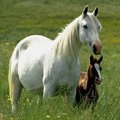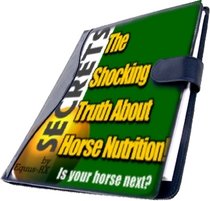Horse Fitness Checklist
The 15 things you must check for...
The Horse Fitness Inspection Check List

These 15 steps are easy to check and strong indications of a horse's health. You will be evaluating traits, condition and behavior in a short, powerful, direct, and easy to understand 15 step process. This is a great way to evaluate your horse quickly (10 minutes or less) and easily to see just how they may be feeling.
The 15 steps are:
Required Items: Stethoscope, watch, rectal thermometer.
1) Check to see if your horse is alert with their ears moving back and forth.
- If they are back it means they are mad and unhappy.
- Movement back and forth means a good alert aware horse.
2) Their coat is a nice glossy look to it and the hair is lying flat on their body.
- If the hair is raised up, beware its like a cat that raises it's hair. It's afraid and anxious.
- If the coat isn't nice and glossy, your horse may be lacking some essential vitamins and minerals in their diet.
The Truth About Horse Nutrition
Feeding your horse has never been easier than it is today ... but it has also never been more difficult. Thanks to commercial feed manufacturers and innovations in technology and transportation, feed is now available year-round.
Download this report and learn:
- The 6 things you must know before you feed your horse.
- Is your Horses Protein working?
- Is it possible to kill my horse with water?
- Is it true vitamins give my horse energy?
- More...
3) When you run your hand over their body, their skin is loose and supple and moving easily over the underlying bones.
- If you can feel and see the bones, chances are your horse is malnourished. Right-click, and "save as" on the following link to download a conditioning chart created by horsesecrets.com (Equine Condition Score)
- If you find the horse is thick, it may be overweight. The conditioning chart offers an easy evaluation method.
4) Their eyes are open and bright. When you check under the lids and into the linings of their nostrils you find a nice pink color to the tissue.
- If the eyes are dull and listless there may me an infection or some other form of discomfort your horse may be experiencing. Remember the eyes are the window of the soul.
- If the tissue isn't nice and pink there's a concern for adequate blood supply and blood flow.
5) When your horse is at rest, they don't appear to be overheated or sweating. (This of course isn't a good test in really hot weather.)
- This is a symptom that your horse is in distress.
6) They're eating well, (their normal intake of food) and they are chewing normally. (This is based on their normal habits.)
- If you see a change in their normal routine you must take notice.
- This could be the hint of bad things to come. Remember horses love routine. They do best with routines. If the horse changes...be on the look out.
- This habit change refers to manner as well as diet changes.
7) After you check out the Body Conditioning chart they fall between 5 and 7. They’re filled out and smooth.
- Right-click, and "save as" on the following link to download a conditioning chart created by horsesecrets.com (Equine Condition Score)
8) Their legs are smooth, and cool. Using an analogy, think of injuries that you have received where you were bruised and think about the swelling and how hot that area became.
- The legs have no swelling.
- There are no hot or swollen areas.
9) Make sure when they are at rest they are not favoring a leg.
- This leg could be sprained or otherwise injured.
- Please note resting one of their hind legs is normal but it is not normal if they rest a front leg. This is certainly a sign of injury.
10) Another indication of a sprain or injury can be noticed when they walk.
- It is important to see a smooth, natural gait that does not favor any one leg.
11) Internal injuries may be noticed during urination.
- Urine must be light yellow or colorless and will be fairly thick.
- If its brite yellow, you need to make sure they have enough water.
- They should be urinating several times a day.
12) Their manure should also be occurring a number of times per day.
- The color will vary based on what they are eating and is to be expected.
- The manure should not have an offensive odor to it and be relatively firm.
13) When your horse is at rest and relaxing, their breathing rate should be between 8-12 breaths a minute.
- This is a general number as it also depends on the fitness of the horse.
- It becomes an issue when it is grossly higher or lower.
- The same holds true for their heart rate.
14) Their pulse should be 36-42 beats per minute.
15) Temperature (which is taken rectally) is 38 degree Celsius or 100-101 Fahrenheit.
The above article is sponored by horsesecrets.com





